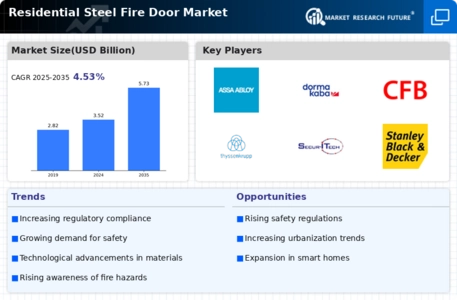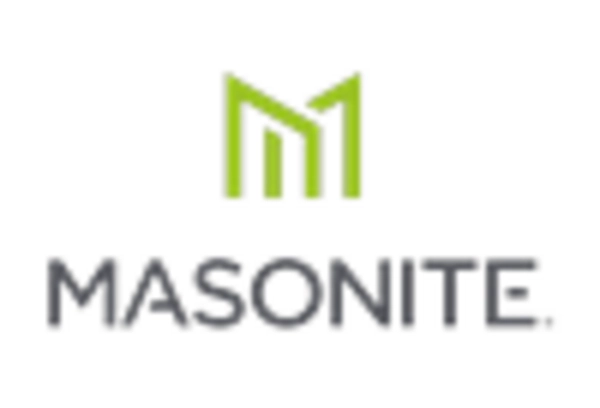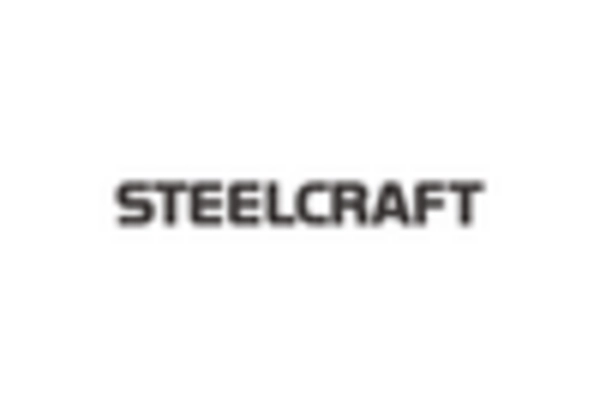Increasing Awareness of Fire Safety
The rising awareness of fire safety among homeowners is a crucial driver for the Residential Steel Fire Door Market. As individuals become more informed about the risks associated with fire hazards, the demand for effective fire protection solutions, such as steel fire doors, is likely to increase. This heightened awareness is often fueled by educational campaigns and regulatory requirements that emphasize the importance of fire safety in residential settings. Consequently, the market for residential steel fire doors is projected to grow, as homeowners seek to enhance their safety measures. In fact, the market is expected to witness a compound annual growth rate of approximately 5% over the next few years, reflecting the increasing prioritization of safety in residential construction.
Regulatory Standards and Building Codes
The enforcement of stringent regulatory standards and building codes is a significant driver for the Residential Steel Fire Door Market. Governments and local authorities are increasingly mandating the installation of fire-rated doors in residential buildings to ensure occupant safety. These regulations often specify the types of materials and construction methods that must be used, thereby creating a robust demand for steel fire doors, which are known for their durability and fire resistance. As municipalities continue to update their building codes to reflect modern safety standards, the market for residential steel fire doors is likely to expand. This trend is indicative of a broader movement towards enhancing safety protocols in residential construction, which could lead to a substantial increase in market size.
Growing Construction and Renovation Activities
The ongoing growth in construction and renovation activities is a pivotal driver for the Residential Steel Fire Door Market. As new residential projects emerge and existing homes undergo renovations, the need for compliant and effective fire safety solutions becomes increasingly apparent. Builders and contractors are recognizing the importance of incorporating fire-rated doors into their designs to meet safety regulations and enhance property value. This trend is further supported by the increasing investment in residential construction, which is projected to rise steadily in the coming years. Consequently, the demand for residential steel fire doors is expected to follow suit, as these products are integral to modern construction practices that prioritize safety and compliance.
Technological Advancements in Fire Door Design
Technological advancements in the design and manufacturing of fire doors are driving innovation within the Residential Steel Fire Door Market. Manufacturers are increasingly incorporating advanced materials and engineering techniques to enhance the performance and aesthetic appeal of steel fire doors. For instance, the integration of thermal insulation and improved locking mechanisms not only boosts fire resistance but also enhances energy efficiency. As consumers become more discerning about both safety and design, the demand for these technologically advanced products is expected to rise. This shift towards innovation is likely to contribute to a more competitive market landscape, with companies striving to differentiate their offerings through superior design and functionality.
Consumer Preference for Durability and Security
Consumer preference for durability and security is a driving force in the Residential Steel Fire Door Market. Homeowners are increasingly seeking products that offer long-lasting performance and enhanced security features. Steel fire doors are recognized for their robustness and ability to withstand various threats, including fire and forced entry. This growing inclination towards durable and secure home solutions is likely to propel the demand for steel fire doors, as they provide peace of mind to homeowners. Additionally, as crime rates fluctuate and safety concerns rise, the emphasis on security in residential properties is expected to further boost the market. This trend indicates a shift in consumer behavior towards investing in high-quality, reliable safety products.


















Leave a Comment